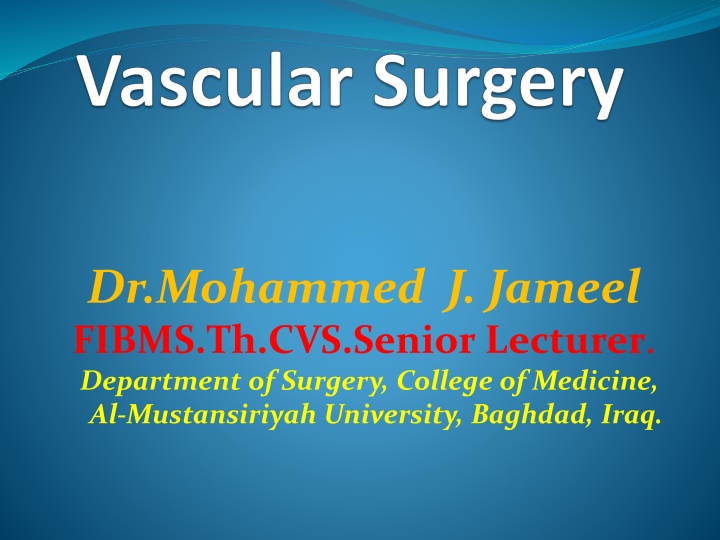
Vascular Injuries: Etiology, Pathophysiology, and Clinical Evaluation
Explore the etiology, pathophysiology, and clinical evaluation of vascular injuries, including causes such as blunt trauma and penetrating injuries. Learn about the symptoms and indicators that may signify vascular injury, leading to emergency operative exploration.
Download Presentation

Please find below an Image/Link to download the presentation.
The content on the website is provided AS IS for your information and personal use only. It may not be sold, licensed, or shared on other websites without obtaining consent from the author. If you encounter any issues during the download, it is possible that the publisher has removed the file from their server.
You are allowed to download the files provided on this website for personal or commercial use, subject to the condition that they are used lawfully. All files are the property of their respective owners.
The content on the website is provided AS IS for your information and personal use only. It may not be sold, licensed, or shared on other websites without obtaining consent from the author.
E N D
Presentation Transcript
Dr.Mohammed J. Jameel FIBMS.Th.CVS.Senior Lecturer. Department of Surgery, College of Medicine, Al-Mustansiriyah University, Baghdad, Iraq.
Lec: 4 Vascular Injuries:- Etiology:- 1. Pentrating injuries: a- Low velocity injuries like knife, pistol in which the damage is mainly confined to the wound tract. b- High velocity injuries like missiles, gunshot which leads to soft tissue cavitation and impact injury to the bone here the involved artery usually destroyed and/or thrombosed for several Cms beyond the path of penetration. 2. Blunt trauma: a- Compressive force can damage arterial wall directly. b- Rapid deceleration may stretch the artery and leads to intimal tear since it is the least elastic layer of the arterial wall, blood will dissect under intimal flap leading to thrombosis of vessel.
Pathophysiology:- 1. Complete cut of an artery here the cut ends will constrict and retract into adjacent tissue, bleeding usually stop due to vasoconstriction and development of firm thrombus in each of the two ends, clot tend to propagate distally till the flow is restored by collateral circulation here distal blood flow will be lost and ischemia develop whose severity vary according to a- the site of interruption. b- the quality of collateral vessels c- the demand of distally supplied tissue. Symtomsare usually found one major joint below the site of arterial injury, the skin become cold, pale or mottled with numbness or sensory loss, loss of movement, sometimes these findings may delay and loss of pulse is the only finding, in some cases recurrent episodes of bleeding may occur and alarm prescenceof vascular injury.
2. Partly injuried artery in which part of arterial wall remain intact and complete arterial contrictioncannot occur as in case of total injury this will produce serious or recurrent bleeding, large hematoma may develop and usually become pulsatile since it communicate with arterial lumen, blood flow may be maintained distally and end- organ ischemia is less found, it may escape diagnosis initially and later will present as an expanding hematoma, false anuyrism or arteriovenous fistula. 3. Non Severed artery here intimal damage produce intra- arterial thrombosis and arterial flow will be lost or decreased but without external bleeding, examination may be normal initially, but signs of ischemia may develop over a variable period of time.
Clinical evaluation:- most arterial injuries can be identified readily because of external bleeding or large hematomas, ischemia distal to the injury is uncommon with isolated vascular injury except for wounds of popliteal and common femoral arteries, moreover, distal arterial pulses may be intact in 20% of cases, the clinical indications for emergency operative exploration of a suspected vascular wound are summarized as following. 1. Diminished or absent distal pulse. arterial bleeding. 3. Large or expanding hematoma. 4. Major bleeding with hypotension or shok. 5. Bruit at or distal to suspected site of injury. 6. injury of anatomically related nerve. 2.Persistant
When they are available and the conditions are appropriate Dopplarstudy and Angiography can be very helpful in the evaluation of potential arterial injuries especially in multi- injured patient, moreover, surgical management may be improved by identifying the site and extent of vascular damage. Operative Mangement:- all major arterial injuries should be repaired provided that the tissue they supply is viable and the general condition of the patient is satisfactory, the urgency of repair is directly related to the degree of ischemia, although every hour delay may diminish success rate, there is no absolute period beyond which repair is contraindicated, following steps must be done.
1. Ensure safe airways and breathing, control external bleeding with direct pressure and packing of bleeding site, proximal torniqet is better to avoided, but if they are necessary the time period of its application must be calculated, antibiotic and tetanus prophylaxis are given, when present other injuries are evaluated and priority determined 2. A wide operative field is prepared including the other limb in cases of lower limb injury to allow Saphenousvein graft(SVG) harvesting when it is required, vertical incisions along the course of injured vessel are used and proximal and distal control of vessel obtained to decrease the amount of bleeding.
3. Both proximal and distal ends of injured vessel are dissected out, Embolectomyusing Fogarty catheter of both segments done to remove any present clots, irrigation with Heparin/Saline solution done, both ends are trimed and continuity of the vessel is re-established either by direct end to end anastamosis or when the lost segment is large by reversed SVG interposition, hemostasissecured, wound debrided, anastamosis must be covered with muscle or flap, drain put and incision closed. 4. post-operative care include maintenance of normal intravascular volume, distal pulse evaluation by examination and/or dopplarstudy and moniterof distal limb to avoid development of compartment syndrome.






















